Today’s guest post comes from Nightgear, a UK retailer of tactical gear:
Accoutrement is the term used to describe items carried on a soldiers person. In modern military jargon it would be referred to as the Fighting Load. Having spent a lot of years carrying around a fighting load I was curious at what this equipment had transformed into from even 20 years ago when I last wore an ALICE pack and took a look at how it had changed over the last 200 plus years.
Accoutrements have always been used to meet two needs – items to fight and items for sustenance. The fighting items would include ammunition, bayonet, and later things like grenades. The sustenance items include food, water, bedding, and spare clothing. These two equally important needs are what ensures a soldier’s ability to survive and be effective in battle.
In 1777 in Massachusetts the first attempt at standardized US military equipment was made. Until that time the militia was left to their own devices to find ways to carry equipment. The first equipment (not surprisingly) was based off British design and consisted of a scabbard, a bayonet carriage, a cartridge box for ammunition, and a haversack and canteen for food and water. A bedroll was made up by the soldiers to be worn across the back.
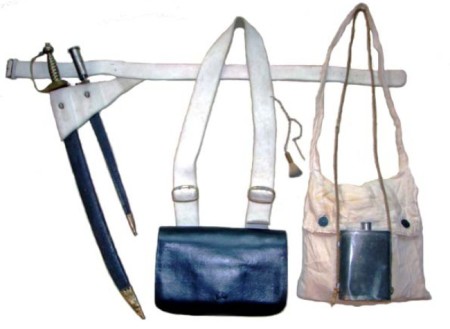
This pattern was continued until 1808, at which time the military switched to the .69 caliber musket and changed the cartridge box slightly to accommodate that. All of these earlier accessories used white leather belts officially but in practice a shortage of buffalo hides around the War of 1812 made use of black leather more widespread.
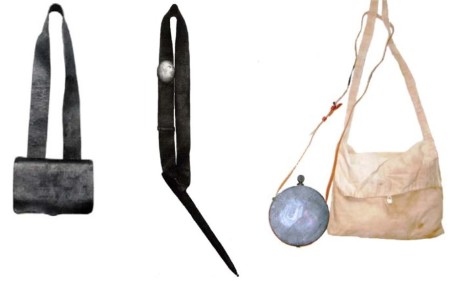
You may also notice the sword scabbard had disappeared from the rank and file, being used only by officers.
The next change to the carrying equipment occurred in 1828, once again predicated by the introduction of a new weapon – in this case the flintlock musket. This new design of the cartridge box was a much more ornate and decorative design and incorporated the US and Eagle Symbols. Six years later in 1834 the saber belt was also modified and re-patterned for the dragoon regiments. In this formation the first look of the modern design is clearly evident using the belt to carry the equipment and shoulder straps to distribute the weight of equipment over the soldier’s body.
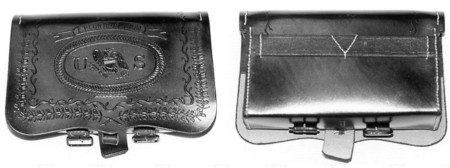
This pattern was relatively short lived as the introduction of the hall carbine rendered yet another change to the cartridge box. It also introduced the standardized bedroll pack.
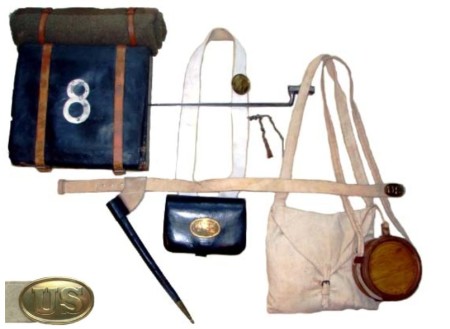
By the Civil War standard Union Fighting load consisted set of items:
Pattern 1855 two-bag Knapsack
Pattern 1851 infantry equipment belt
Scabbard for the M1855 Socket Bayonet
Pattern 1861, .58 Caliber Rifle-Musket Cartridge Box
Pattern 1851 haversack
Pattern 1858 canteen, with tinned iron cup
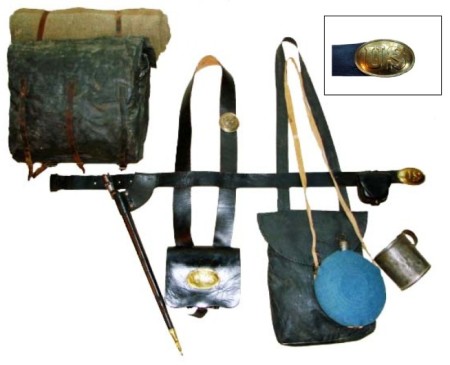
By 1878 the equipment had undergone another transformation. There are many other smaller changes throughout these years – most notably the differences in the infantry equipment and cavalry equipment as one might expect.
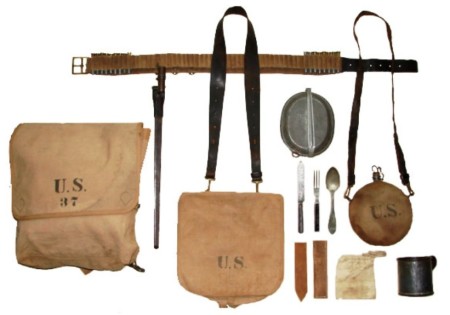 In 1909 the Infantry Equipment board was assembled and conducted studies and tests on what a soldier needed to carry and how the weight was distributed. It made the major change of turning the haversack into a backpack and adding individual ammo pouches to the belt and webbing to replace shoulder straps. This version lasted throughout WWI and beyond. At the end of WWI there was so much surplus equipment that soldiers were issued two full sets (one for parade and one for field) and virtually no changes were introduced until the beginning of WWII.
In 1909 the Infantry Equipment board was assembled and conducted studies and tests on what a soldier needed to carry and how the weight was distributed. It made the major change of turning the haversack into a backpack and adding individual ammo pouches to the belt and webbing to replace shoulder straps. This version lasted throughout WWI and beyond. At the end of WWI there was so much surplus equipment that soldiers were issued two full sets (one for parade and one for field) and virtually no changes were introduced until the beginning of WWII.
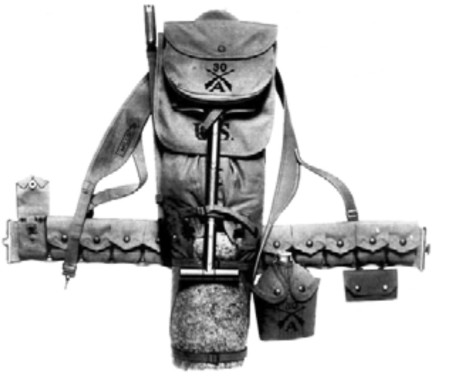
WWII brought the small changes and most notably the introduction of the M1VA1 Carrier which was used for carrying of the protective gas mask. Seen here along with a pistol belt and pack as issued to a specialist solider armed with an M1 Carbine. The majority of US forces continued to use the same pack system as had been issued in WWI, with only minor upgrades.
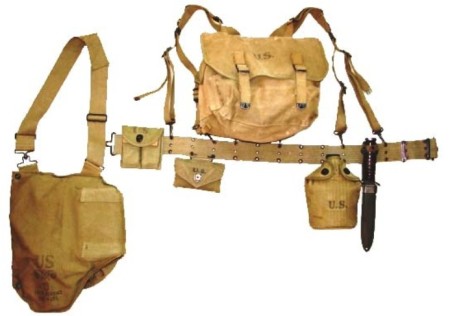
In the 1950’s the Korean War brought introduction of the M1945 Combat and Cargo Packs. While officially introduced in the latter stages of WWII it was not fully distributed until the Korean War. This system finally replaced the clumsy WWI folding haversack design with a true backpack system, and is the direct ancestor of what is used today.
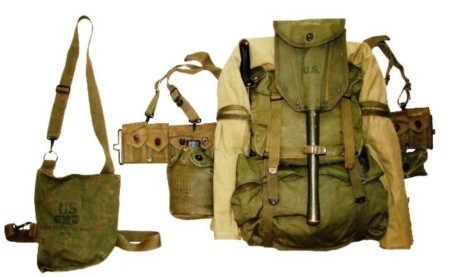
With the Vietnam War another change was made. This time the changes came about because the climate caused the older style to deteriorate and fabric was changed from canvas to nylon and plastic. This is the M1967 Modernized Load Carrying Equipment.
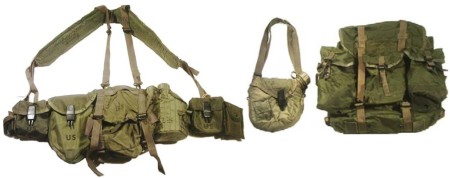
In 1974 the ALICE (All-purpose Lightweight Individual Carrying Equipment) pack was introduced. This was the framed pack to go with the suspender-based load bearing belt still in limited use today by National Guard and reserve troops (but more commonly found in Army-Navy surplus stores and filled with under armour baselayers and surplus military paraphernalia).
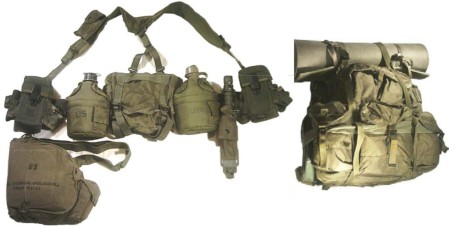
The ALICE system has been replaced in recent years by MOLLE (Modular Lightweight Load-Carrying Equipment). Original distribution began in the late 1990s to special operations forces, with widespread distribution beginning in 2003. This more flexible modular system allows for a great number of variations based on individual soldier and mission-specific needs, while still using a standard base.
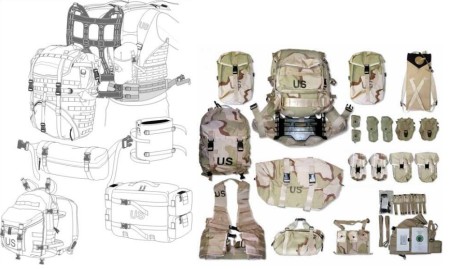
In addition to military use, MOLLE equipment has caught on quickly in civilian culture with outdoor enthusiasts, survivalists, and hikers. When used in the civilian culture, MOLLE packs are more apt to be filled with survival gear from places like www.rvops.co.uk rather than standard military issue kit.
There is much discussion and debate on the evolution of the accoutrements used by soldiers to carry fighting equipment and food and water. Though obvious that modern equipment and materials have some technological advances they still serve the basic function to “keep beans and bullets” in the hands of the soldier. The progress has come at the cost of weight and mobility as clear if you look at the relatively simple equipment of 200 years ago. Interestingly, the MOLLE system was designed to allow the soldiers the ability to shed some of that excess weight and get back to ammo, water, food, and a bayonet when in actual combat – the same as 236 years ago.
Want to see more detailed coverage of US Army accoutrements, uniforms, and small arms? Check out this PDF Survey of US Army Uniforms, Weapons, and Accoutrements by David Cole.

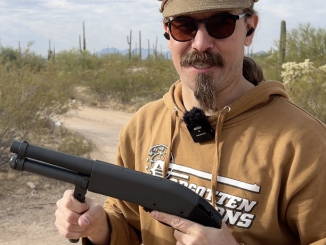
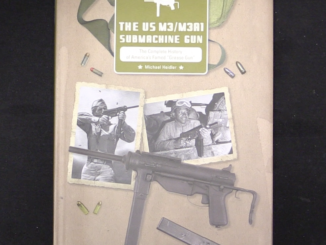
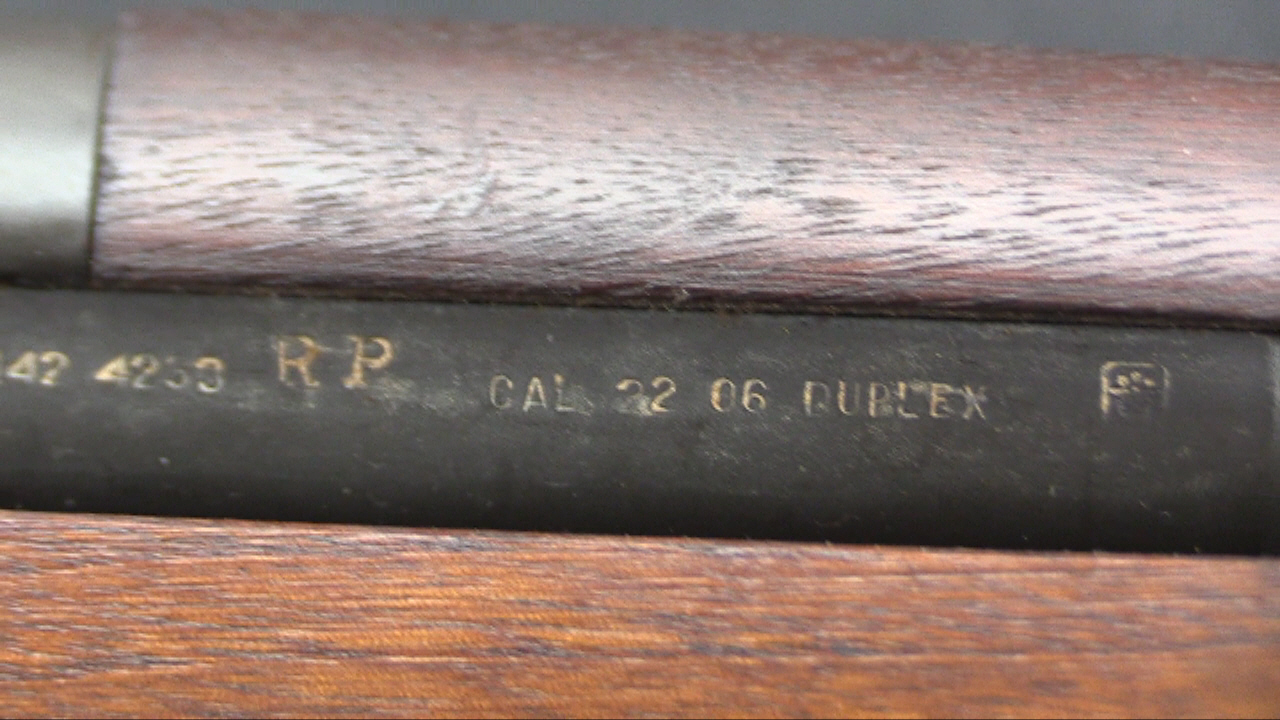
An excellent article on the evolution of military load-bearing equipment. In some quarters, use of the load-bearing harness alone with ammunition, water bottle, grenade, map and other pouches is referred to as being dressed in SBO ( Skeleton Battle Order ), while adding an equipped backpack or Bergen rucksack to the SBO is classified as being dressed in FBO ( Full Battle Order ). There are many variations on the theme such as the use of specific chest rigs and tactical vests, with or without modular body armor.
It will be interesting to see what the future holds in the form of an eventual replacement for, or evolution of, current MOLLE gear. The latest generation of hybrid load-bearing equipment designed in Israel, eg., the MAROM Dolphin, appears to combine many features of the chest rig, tactical vest and load-bearing harness in an attempt to provide the user with the efficiencies of each type while eliminating the major disadvantages.
Just an FYI
Kit is the term used in the UK, et.al.,to describe items carried on a soldiers person.
Awesome post, you’ve done it again.
One warning, though: just because something is adopted in year YYYY doesn’t mean the troopies instantly start toting it. In the 1970s and 1980s in one of the nation’s highest priority units, our default for web gear was a mix of canvas and nylon stuff. Many of the guys preferred the canvas because it was quiet. The nylon on nylon makes a distinctive noise, something you don’t want when you’re sneakin’ an’ peekin’ (aka Conducting Strategic Reconnaissance).. On the plus side of the ledger for nylon it doesn’t absorb its own weight in water like the canvas (army term, “cotton duck”) stuff did
Most combat units have a very rigid gear SOP. It’s not to harsh snuffy’s mellow, but because there are real advantages to a consistent cross-load in combat. If it’s night and you’ve just taken one for the team, it’s better for me to know exactly where your cravat bandage and burn powder (or nowadays, Israeli bandage, quickclot, tourniquet) are.
On small SF teams we ran on Big Boy Rules, where you ran what you wanted for gear — I had a vest made from an aviator’s survival vest with other stuff sewed to it– but it was your tough luck if your team medic couldn’t find your stuff. Team equipment (demo, radios, a belt of spare ammo, etc.) was crossloaded and the locations memorized pre-mission. The Colonel might ask you, “where’s the blood expander?” and you ad better know that every man has one liter in the left outer pocket of his ruck and the medic carries two extras. There was always a bit of tension between longtime SF guys and new guys coming over from Big Green or the Ragnars, who were used to doing it by the book.
There’s also another advantage to running the exact same stuff in the exact same location as everybody else: wear high-speed gear and you can draw a sniper’s interest. This can be non-habit-forming.
Excellent and very pertinent observations — we operated pretty much according to the same sort of protocols regarding load-bearing harnesses adjusted to suit the anticipated situation at hand. The more rigidly-minded unit officers would absolutely insist on conformity, sometimes regardless of common sense. But one point in their favor was the fact that no-one stood out as a possible special target due to different-looking gear.
Just looking at the Cole thing. (I missed my plane, and so I can work or read ForgottenWeapons.com… until the next jet. heh).Somehow I think I’ve seen it before, but it’s extremely good. I didn’t know the blue Continental uniforms took so long to standardize on, nor that the Continentals of Boston and perhaps Saratoga were clothed in catch-as-catch-can fashion.
Does he write regularly somewhere? Has he books in print? I suspect I can learn a lot from that guy.
“The next change to the carrying equipment occurred in 1828, once again predicated by the introduction of a new weapon – in this case the flintlock musket.”
Huh?
“Original distribution began in the late 1990s to special operations forces”
I find that interesting, considering the MOLLE ruck can’t be worn on Airborne ops. You would think if SOF did T&E first, they would have spoken up about that quickly. That may be the official story, but it’s hard to believe.
John, the MOLLE was authorized at one time. In fact, it was designed to be attached to a jumper’s harness with two straps that are stowed inside (the white straps). After a few lost rucks, the Airborne Board required the MOLLE to be rigged like an ALICE, in the standard h-harness, which is not really suitable. That’s probably the genesis for any MOLLE jump ban.
The old airborne board was a lot better at empire-building and throwing their weight around than they were at supporting the field units, and slowed down or stopped more advancement that you could imagine. Dunno if the new version “operational test directorate” is any better.
http://www.otc.army.mil/directorates/abnsotd.html
Skype has launched its internet-based client beta towards the
entire world, right after introducing it broadly from the Usa and You.K.
previously this four weeks. Skype for Online also now works with Chromebook and Linux for
instant online messaging conversation (no video and voice yet, individuals need a connect-in installation).
The expansion from the beta brings assistance for an extended list of
different languages to aid reinforce that worldwide functionality
Indian Armour provides tactical vests and combat gear with MOLLE webbing system, emergency buddy drag handle, side release buckles and many more features.
https://www.indianarmour.com/Tactical-Vest.html
20 th sfg had a company in the Louisiana National guard. Everybody had mountain rucks and pistol belts and we jumped with them on release lines. We also tied our m16s to our harness with baling twine.
Nice post but I would have liked to have seen the M1956 stuff in there.